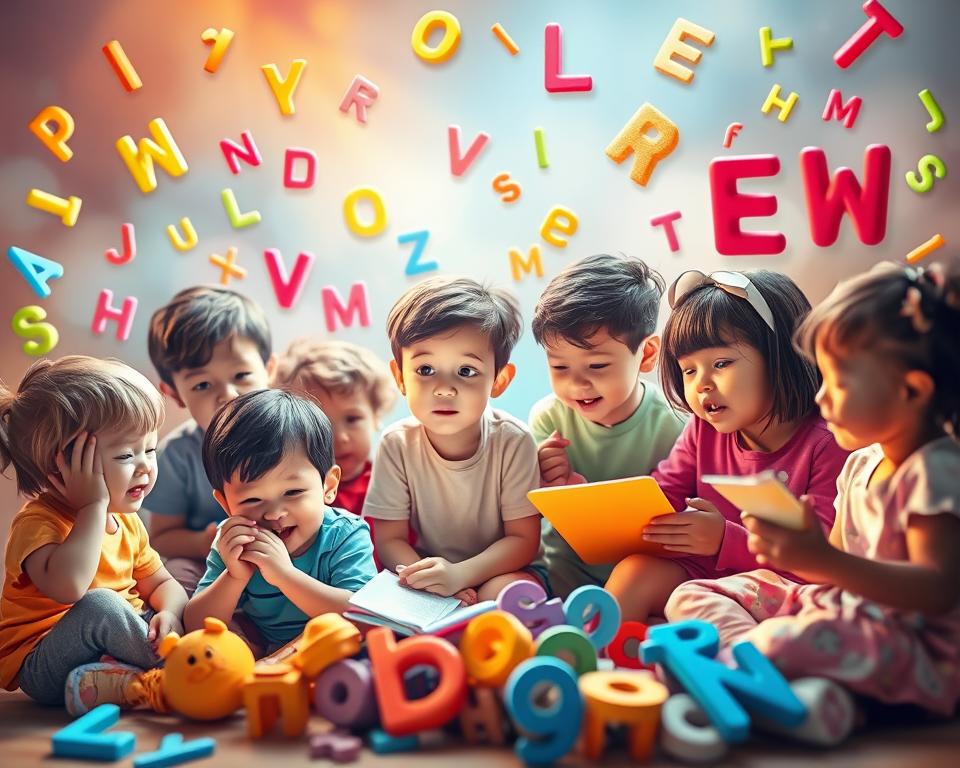Between 18 months and 5 years, kids learn about 10 new words daily (Anglin, 1993). This amazing growth is shaped by both inside and outside factors. Knowing the language development theories behind language learning helps parents and teachers support kids better.
Language development is a complex and interesting field. Many theories explain how kids learn to speak and understand language. From the behavioral to the nativist view, each theory gives us new insights into this human ability. By looking into these theories, parents can understand the incredible journey of learning a language.
Understanding Language Development in Early Childhood
Language development in early childhood is both complex and fascinating. Children learn new words fast, picking up to 10 each day from 18 months to 5 years old. Their ability to learn and process language grows with every interaction.
Children start by understanding language (receptive skills) before they speak their own words (expressive skills). This shows how important early language exposure is for their growth.
Language lets children create new ideas and sentences, not just repeat what they hear. This skill is key for their thinking, social, and school success. Knowing about early language development helps parents and teachers support this important growth.
“Continuous exposure to language from birth and regular interactions, including narrating activities, singing, labeling objects, and discussing daily experiences, significantly benefit language comprehension and development in babies and young children.”
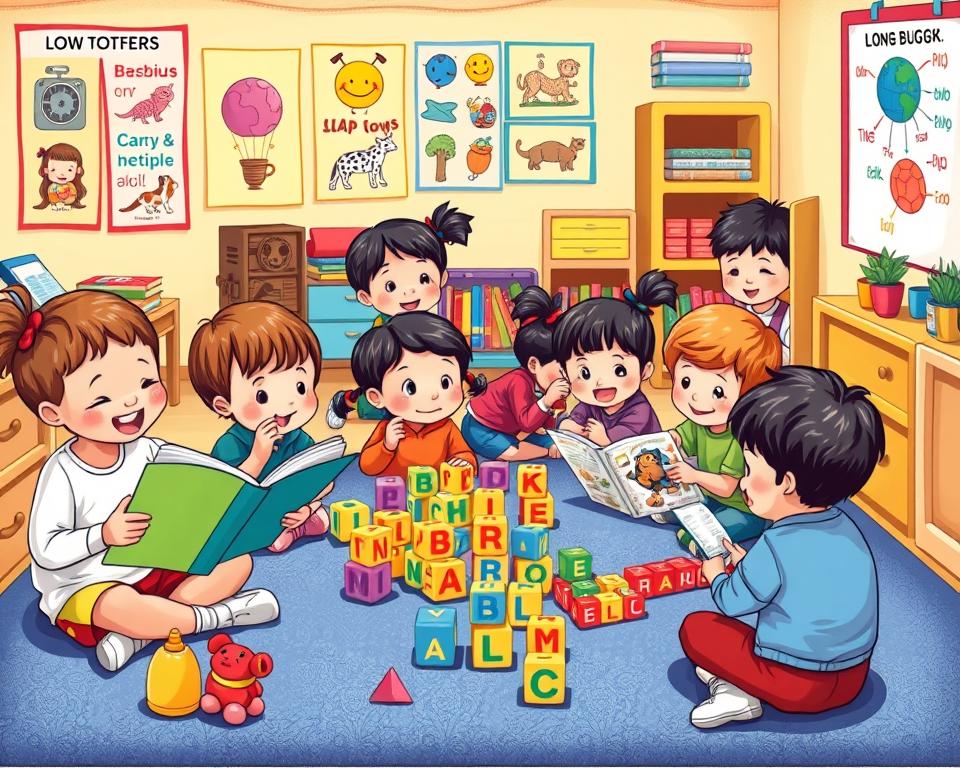
Studies show that family and social interactions greatly impact a child’s language skills. Talking, asking questions, and giving feedback are crucial. A language-rich environment helps children learn and prepares them for the future.
The Behavioral Theory: Learning Through Reinforcement
The behavioral theory, led by B.F. Skinner, says language is learned through operant conditioning. Kids learn language by imitating and copying what adults do. Parents help by rewarding correct language use and giving feedback.
This theory sees the environment as key to learning a language. It views kids as reacting to what’s around them. Learning happens through imitation, praise, and affection, which are seen as rewards.
Studies show kids learn at different rates. The behavioral approach is helpful but has its limits. It might not encourage creativity or fully explain how social influence affects learning.
Still, the behavioral theory has shaped how we teach language. Methods like cueing and token economy systems are used to help kids learn. As research grows, cognitive theories have also been developed to add to what the behavioral theory offers.
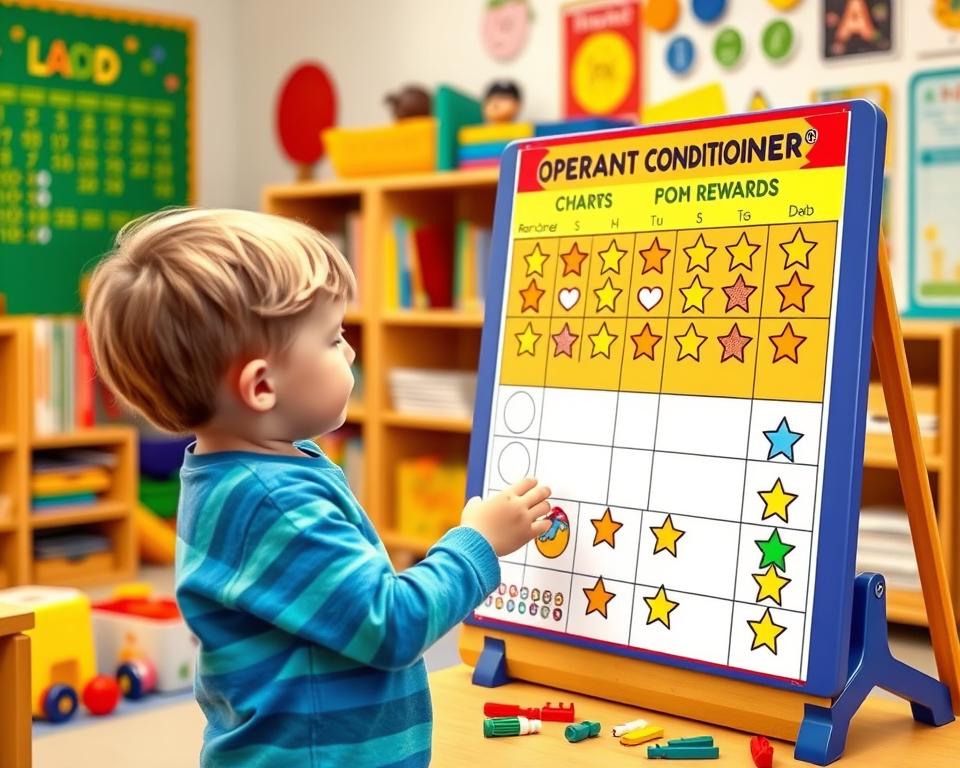
“The process of learning in behaviorism relies on generalization, conditioning, and reinforcement.”
Chomsky’s Nativist Theory and Universal Grammar
Noam Chomsky believes language is innate and comes from our genes. He says we are born with a Language Acquisition Device (LAD) in our brains. This device helps us learn language without needing to be taught.
Chomsky’s ideas have changed how we study language. Over 60% of linguists use parts of Chomsky’s Theory in their work. Lisa Pearl’s study shows how understanding language works. Robert D. Borsley and Kersti Börjars also explored how we learn language.
Chomsky’s theory has evolved over time. He went through different stages, like the generative grammar phase. The Government and Binding Model was his latest idea. It explains how all languages share some rules but also have their own special ways.
“Children between the ages of 18 months and 5 years learn up to 10 new words every day.”
Chomsky thinks our brains are wired to learn language fast. Most people, who are right-handed, use their left brain for language. Left-handers might use their right brain instead. This shows language is linked to our biology.

Chomsky also sees language as a social thing. Young children fix misunderstandings with words, showing they learn from others. There are thousands of languages, but they all follow the same basic rules, Chomsky says.
The Social-Pragmatic Theory of Language Acquisition
The social-pragmatic theory of language acquisition highlights how communication helps develop language skills. It focuses on the interactions between infants and their caregivers. These interactions shape how a child learns language.
This theory believes language development comes from a child’s need to communicate and connect with others. For this to happen, the child and caregiver must be close. They need to meet the child’s basic needs, develop a bond, and share attention.
The theory shows that the social setting is key for learning language. Through talks with caregivers, infants learn how to use language effectively. This is different from older views that saw language learning as mainly a brain activity.
“Pragmatic development is closely related to cognitive development in children, and children master many pragmatic functions when their vocabulary and syntax are still limited.”
Research into this theory has revealed the importance of infant-caregiver interactions in language and communication skills. Studies found that these interactions help develop and improve pragmatic abilities. This is true in family, peer, and educational settings.

The social-pragmatic theory gives a fresh view on how we learn language. It shows that communication and the social environment are crucial. By knowing this, parents and teachers can help create better learning environments for children.
5 Language Development Theories and Their Impact on Modern Education
The five main language development theories have greatly influenced today’s education. Teachers and speech-language pathologists use these theories in many ways. They teach specific language skills, consider how our minds grow, and focus on how we learn from each other.
Understanding these theories helps teachers create better learning plans. This is especially true for kids who struggle with language.
Noam Chomsky’s Nativist Theory and Universal Grammar idea is very influential. It says we’re born ready to learn languages. Teachers can help by making learning environments rich in language.
The Behaviorist Theory by B.F. Skinner is all about learning through rewards. Teachers can use this by giving positive feedback for good language skills, like learning new words or using sentences right.
The Social-Pragmatic Theory shows how important talking and working together are for learning language. Teachers can help by setting up chances for students to talk and work together.
- The Semantic-Cognitive Approach looks at how our minds process language, like understanding, remembering, and solving problems.
- The Affective Filter Hypothesis by Stephen Krashen talks about how feelings, like fear and excitement, affect learning language.
By knowing these theories, teachers can make better language learning strategies and educational approaches. Using these ideas in teaching can really help students get better at language. It also helps them do well in school.

“The true sign of intelligence is not knowledge but imagination.” – Albert Einstein
The Semantic-Cognitive Approach to Language Learning
The semantic-cognitive theory, inspired by Jean Piaget, links language learning to cognitive growth. It says a child’s language skills match their thinking abilities. This view focuses on the meanings and ideas in a child’s words, not just the language structure.
This theory believes language learning grows with a child’s mind. As kids develop, so do their language skills. This is why they might use words wrong, even if they understand the idea well.
- The semantic-cognitive approach shows how cognitive abilities and language behavior work together.
- It stresses the need to understand the meanings and ideas in a child’s words.
- This theory helps explain why kids might know things but not say them right.
This approach shows how important it is to see language and thinking as connected. It helps parents and teachers understand a child’s language better. This leads to better ways to teach and support language skills.
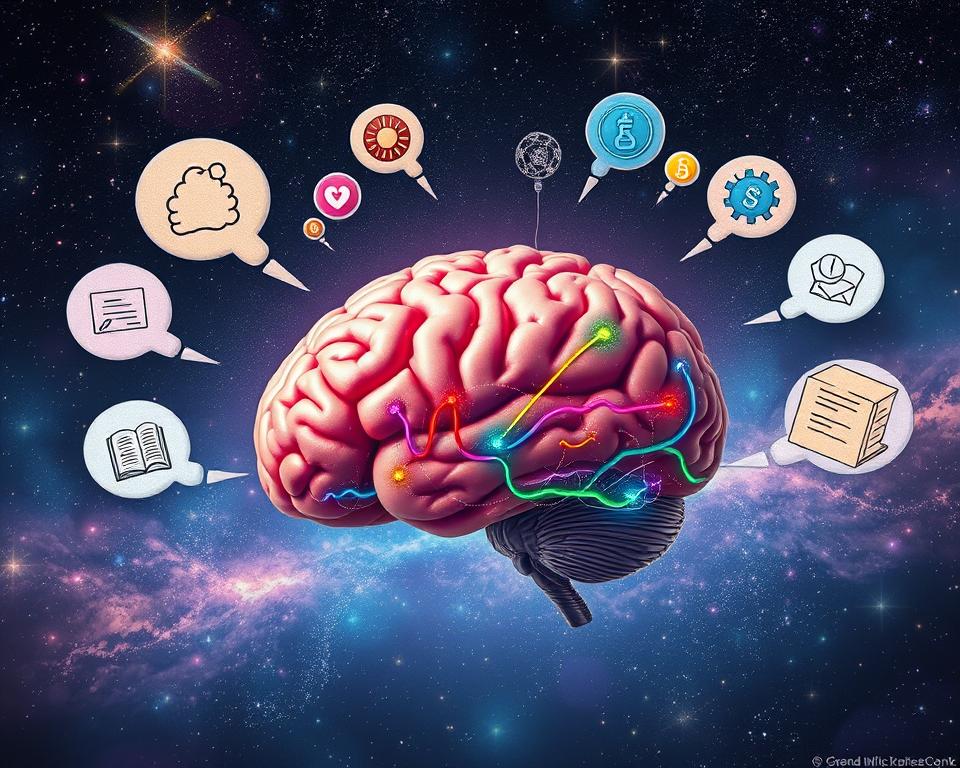
“Language is not just a set of grammatical rules, but a reflection of our cognitive processes and the way we make sense of the world around us.”
Language Acquisition Device: How Children Process Language
The Language Acquisition Device (LAD) is a concept by linguist Noam Chomsky. It explains how kids quickly learn and understand language. This built-in tool is turned on when kids hear language, letting them make and understand sentences without direct teaching.
Chomsky believes kids are born ready to learn any language. Studies show kids don’t just copy what they hear. They make mistakes and handle speech irregularities in their own way.
Chomsky says kids learn their native language’s grammar by age five or six. This is a key time for learning languages. Kids who haven’t learned by seven might never fully catch up with their peers.
Even though Chomsky’s LAD theory is popular, some question it. They think kids might learn language through general learning and interaction, not a special device.
“Colourless green ideas sleep furiously” – Noam Chomsky
Chomsky used this sentence to show that phrases can be grammatically correct but still not make sense. This supports the idea that kids have an innate ability to process language.
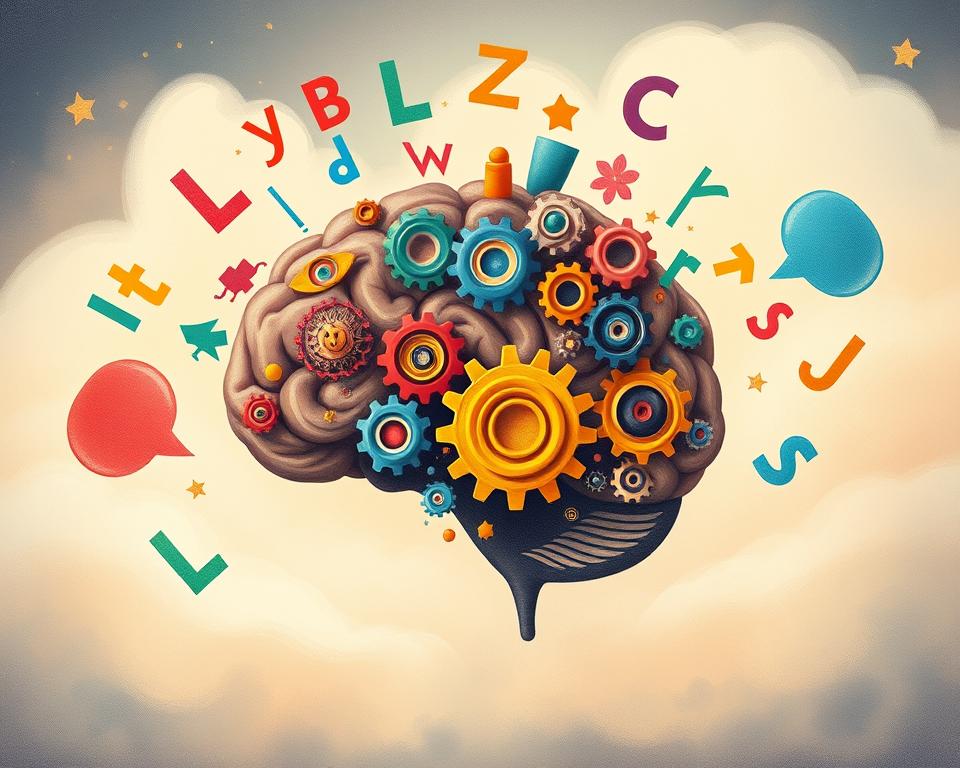
On the other hand, linguist David Crystal suggests kids learn language in stages. They start with simple uses and move to more complex, correct expressions. This shows that learning a language might involve both innate skills and interactive learning.
The debate on the LAD and how kids learn language is ongoing. Researchers are studying how language processing and linguistic mechanisms help kids become skilled communicators.
The Role of Cultural and Linguistic Diversity
Cultural and linguistic diversity are key in language growth. Kids in diverse settings may hear many languages. This shapes their multicultural language development and bilingualism. Things like family language, education, money status, and faith also affect how they speak.
But, research often misses out on the cultural and language backgrounds of those studied. Yet, the differences in culture and language among people can change how they talk and learn languages.
- A study found that by 2000, most urban schools in the USA were very diverse.
- It’s shown that teachers can have racial biases too, just like anyone else. This shows why training is key to reducing bias in schools.
- Trying to get more teachers of color and those who can teach in languages other than English is a step towards diversity in schools.
It’s vital for speech-language pathologists and teachers to understand these diverse influences when working with kids from different cultures.
“Plurilingualism and pluriculturalism are the norm, not the exception, in today’s schools and societies.”
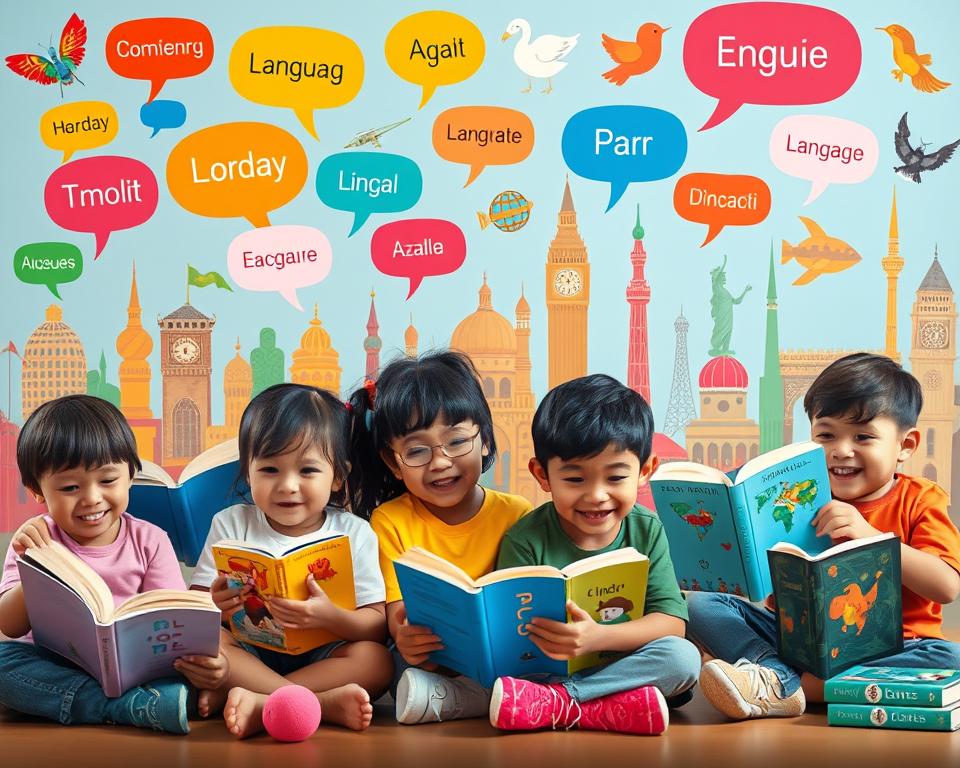
Research has looked into how cultural and linguistic diversity affects learning languages. It points out the need for a better approach. It also shows how embracing many languages can boost creativity and learning strategies in schools.
Practical Applications for Parents and Educators
Parents and educators can use insights from language development theories to help kids learn language. They can engage in conversations, offer rich language experiences, and adjust their communication to fit the child’s level. These methods are very helpful.
For kids with language challenges, speech therapists use different methods. They might use behavioral techniques for specific skills or social-pragmatic methods for better communication. These techniques help kids improve their language skills. Speech therapists guide the use of these methods based on evidence.
Teachers can make learning better by using learning theories like Behaviorism, Cognitivism, and Constructivism. They can adjust their teaching and classroom management to meet the needs of all students. This way, teachers can make a big difference in how kids learn and grow.
The Importance of Understanding Language Development Theories
Understanding language development theories is essential for parents because it equips them with the knowledge and strategies to support their child’s communication skills effectively. Language is a cornerstone of cognitive and social development, and as a parent, being aware of how language develops allows you to nurture this skill at every stage. Here’s why learning these theories is vital:
1. Understanding Developmental Milestones
- Language development theories, such as those by Jean Piaget or Lev Vygotsky, provide a framework for understanding when and how children typically develop linguistic skills.
- Knowing these milestones helps parents recognize whether their child is on track, ahead, or might need additional support.
- For example, B.F. Skinner’s behaviorist theory emphasizes the role of reinforcement in language acquisition, helping parents understand the importance of encouraging speech through praise and repetition.
2. Promoting Effective Communication
- Theories like Noam Chomsky’s Universal Grammar explain the innate ability of children to learn language, highlighting the importance of early exposure to rich and varied vocabulary.
- By knowing these principles, parents can engage in activities like reading aloud, singing, and conversing with their children to foster a linguistically stimulating environment.
3. Supporting Social Interaction
- Lev Vygotsky’s Social Interactionist Theory stresses the role of social interactions in language learning, particularly with caregivers.
- This theory underscores the importance of parent-child dialogue, storytelling, and play in developing both verbal and nonverbal communication skills.
4. Identifying Challenges Early
- Knowledge of language development theories allows parents to spot red flags, such as delayed speech or difficulty understanding instructions.
- Early intervention, informed by these theories, can make a significant difference in overcoming challenges like speech delays, dyslexia, or language processing disorders.
5. Encouraging Multilingualism
- The Critical Period Hypothesis, part of Chomsky’s work, highlights a window of time when the brain is especially receptive to learning languages.
- Parents who understand this can introduce multiple languages early, fostering bilingualism or multilingualism, which benefits cognitive flexibility and cultural awareness.
6. Building Confidence and Bonding
- Language development is deeply tied to emotional security and parent-child bonding.
- By applying insights from attachment theories and language development, parents can create a nurturing environment that boosts their child’s confidence in communication.
7. Empowering Parental Involvement
- Many theories emphasize the role of caregivers in language acquisition. Understanding these theories empowers parents to take an active role in their child’s education, ensuring they feel equipped to be their child’s first and most influential teacher.
Practical Tips for Parents:
- Engage Daily: Speak with your child frequently, even during everyday activities like cooking or shopping.
- Use Positive Reinforcement: Praise attempts at communication to encourage language use, drawing from Skinner’s theory.
- Provide Varied Input: Introduce your child to books, songs, and conversations to expand their vocabulary and comprehension.
- Encourage Social Play: Facilitate opportunities for interaction with peers to develop conversational skills.
Learning about language development theories isn’t just for academics or educators—it’s a practical tool every parent can use to support their child’s growth. With this knowledge, you can nurture a strong foundation for communication, build lasting bonds, and set your child up for success in school and life. Language is power, and as a parent, you hold the key to unlocking your child’s full linguistic potential.
Key Takeaways
- Language development is a complex process influenced by both nature and nurture.
- There are four main theories that explain how children acquire language skills: behavioral, nativistic, semantic-cognitive, and social-pragmatic.
- Understanding these theories can help parents and educators better support a child’s linguistic growth.
- Language development is a universal human capacity, but the process can vary across cultures and individual children.
- Exposure to language, both at home and in educational settings, plays a crucial role in a child’s language acquisition.
Source Links
- Theories of Language Development – https://pressbooks.lib.jmu.edu/topicalchilddev/chapter/theories-of-language-development/
- Theories of Speech & Language Development – https://languageacquisitionpsyc220.weebly.com/theories-of-speech–language-development.html
- The theories of child language acquisition – https://www.mffy.com/blog/the-theories-of-child-language-acquisition-1
- Look Who’s Talking: An In-Depth Look At Language Development – TeachKloud – https://teachkloud.com/psychology/look-who-s-talking-an-in-depth-look-at-language-development-5c65b68fc50e/
- How Language Develops in the First 5 Years – and how you can help – https://www.earlychildhoodspecialties.com/blog/how-language-develops-in-the-first-5-years-and-how-you-can-help
- Behaviorist theory on language acquisition – https://currikicdn.s3-us-west-2.amazonaws.com/resourcedocs/55c33aaf3db04.pdf
- Behaviorism in Education: What Is Behavioral Learning Theory? – https://www.nu.edu/blog/behaviorism-in-education/
- Understanding the Behaviorist Theory of Language Acquisition: Insights into Human Learning – https://medium.com/@devenakhiyani14/understanding-the-behaviorist-theory-of-language-acquisition-insights-into-human-learning-8f39ad176184
- Chomsky’s Theory – https://www.structural-learning.com/post/chomskys-theory
- Theories of Language Development | Lifespan Development – https://courses.lumenlearning.com/suny-lifespandevelopment/chapter/theories-of-language-development/
- PDF – https://openlab.bmcc.cuny.edu/ece-110-172/wp-content/uploads/sites/1578/2021/05/Theories-of-Language-Acquisition.pdf
- The social-pragmatic theory of word learning – https://benjamins.com/catalog/prag.10.4.01tom?srsltid=AfmBOooUe3ZYSABjpR5FuhhO0J4SkEWUQBV-0M8eh-Z4XVIVF3_jpI_t
- Pragmatic Language Development: Analysis of Mapping Knowledge Domains on How Infants and Children Become Pragmatically Competent – https://pmc.ncbi.nlm.nih.gov/articles/PMC9497940/
- 8 leading theories in second language acquisition – https://sanako.com/8-leading-theories-in-second-language-acquisition
- Five Educational Learning Theories – https://www.wgu.edu/blog/five-educational-learning-theories2005.html
- Learning Module Two: Theories That Have Transformed Language Education – https://openpress.usask.ca/languagelearningk12/chapter/learning-module-2-theories-that-have-transformed-language-education/
- Theories of Language Acquisition: Differences & Examples – https://www.vaia.com/en-us/explanations/english/language-acquisition/theories-of-language-acquisition/
- THEORIES OF LANGUAGE ACQUISITION – https://www.montsaye.northants.sch.uk/assets/Uploads/English-Language-Summer-Work-2.pdf
- 4.1 child language acquisition theory – chomsky, crystal, Aitchison & piaget – https://aggslanguage.wordpress.com/chomsky/
- Cultural and Linguistic Diversity in Recent Verbal Behavior Research on Individuals with Disabilities: a Review and Implications for Research and Practice – https://pmc.ncbi.nlm.nih.gov/articles/PMC4883540/
- Linguistic and Cultural Diversity in Language Education Through Plurilingualism: Linking the Theory into Practice – https://link.springer.com/10.1007/978-3-319-44694-3_13
- Teaching Culturally and Linguistically Diverse Students | American University – https://soeonline.american.edu/blog/culturally-and-linguistically-diverse-students/
- Educational Learning Theories | University of Phoenix – https://www.phoenix.edu/blog/educational-learning-theories.html
- Six principles of language development and how to support them in early childhood settings : My College – https://my.chartered.college/early-childhood-hub/six-principles-of-language-development-and-how-to-support-them-in-early-childhood-settings/
- The 5 Key Theories of Educational Psychology in Early Childhood Education and Care – TeachKloud – https://teachkloud.com/psychology/the-5-key-theories-of-educational-psychology-in-early-childhood-education-and-care/



